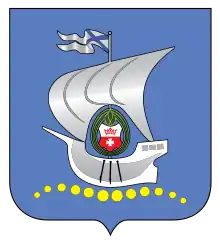Timeline of Kaliningrad
The following is a timeline of the history of the city of Kaliningrad, Russia. The city was known as Königsberg (Polish: Królewiec, Lithuanian: Karaliaučius) prior to 1945 and Twangste prior to 1255.
Era of Teutonic Order
| History of Russia |
|---|
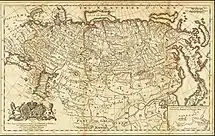 |
|
|
- 1255 – Fortress built by Teutonic Knights during Prussian Crusade, on the basis of a Prussian settlement Twangste.
- 1256 – Settlement formed north of the fortress.
- 1262 – Prussians begin to besiege castle during the Great Prussian Uprising.
- 1264 – Settlement developed south of the castle.
- 1286 – Königsberg chartered.[1]
- 1300 – Town of Löbenicht built.[2]
- 1324 – Town of Kneiphof founded.[2]
- 1333 - Construction of Königsberg Cathedral begins.[1]
- 1340 – Königsberg joins Hanseatic League.[1]
- 1377 – Köttelbrücke (bridge) built.[3]
- 1379 (or 1397) – Schmiedebrücke (bridge) built.[4]
- 1380 – Cathedral built in Kneiphof (approximate date).
- 1387 – Kneiphof Town Hall renovated.
15th century
- 1440 – The city becomes a founding member of the anti-Teutonic Prussian Confederation.
- 1454
- March: Inclusion of the city, in Polish known as Królewiec, within the borders of the Kingdom of Poland following a request of the Prussian Confederation.[5]
- March: The local mayor pledged allegiance to the Polish King during the incorporation of the region in Kraków.[6]
- March: City authorized by the Polish king to mint Polish coins.[7]
- April: City becomes the capital of the Królewiec Voivodeship within Poland.[8]
- 1455 – Captured by Teutonic Knights during the Thirteen Years' War.
- 1457 – City becomes capital of the State of the Teutonic Order.[1]
- 1464 – Georg Steinhaupt becomes mayor.[3]
- 1465 – Landing force from Polish-allied Elbląg destroyed the shipyard near the Old Town, preventing the Teutonic Knights from rebuilding their fleet until the end of the Thirteen Years' War.[9]
- 1466 – Second Treaty of Thorn: the city becomes a part of Poland as a fief held by the Teutonic Order.[10]
16th century
- 1519–21 – Polish-Teutonic War. The city opposed the Teutonic Knights' war against Poland and demanded peace.[11]
- 1520 – Mikolaj Firlej lays siege to the town
- 1521–24 – Secularization of the Teutonic Order
- 1523 – Printing press in operation.[12]
- 1525 – Treaty of Kraków: Königsberg/Królewiec becomes the capital of the Duchy of Prussia, Albert becomes first Duke of Prussia[1] as a vassal of Poland.[8] Treaty confirmed by city representatives.[13]
- 1529 – Castle Library established
- 1542 – Pedagogium founded by Albert Hohenzollern in Kneiphof
- 1544 – Albertina University (Lutheran) founded by Albert, Duke of Prussia.[2][1][8]
- 1545 – Oldest Polish catechism published by Jan Seklucjan.[14]
- 1547 – Catechism of Martynas Mažvydas published.
- 1550 – Population: 14,000.[11]
- 1553 – Oldest Polish translation of the New Testament, by Stanisław Murzynowski, published.
- 1560 – 28 March: King Sigismund II Augustus of Poland confers university privileges on the Albertina University,[8] on a par with the Jagiellonian University.
- 1566
- Duke Albert attempted to introduce absolutist rule in violation of the Treaty of Kraków.[13]
- August–October: Stay and intervention of Polish Royal commissioners, restoration of the previous legal order.[13]
- 4 October: Decree expanding the rights of Polish rulers and of the nobility and cities in the duchy.[13]
- 22 October: Decree settling the city's conflict with Duke Albert, instituted by Polish Royal commissioners.[15]
- 1568 – March: Albert Frederick becomes Duke of Prussia.
- 1577 – City opposes the regency of George Frederick, Margrave of Brandenburg-Ansbach.[15]
- 1579 – Renewed city resistance to the regency of George Frederick. The city supports the nobility's request to the Polish King to send a Polish Royal Commission to the city.[15]
- 1580 – Arrival of George Frederick to establish his rule.[15]
- 1590 – Green Bridge rebuilt.
- 1594 – Schlosskirche (castle church) dedicated
17th century
- 1616 – A Catholic church erected by order of King Sigismund III Vasa and the bishop of Warmia
- 1618 – Duchy of Prussia passes under control of Electors of Brandenburg, August: John Sigismund becomes Duke of Prussia
- 1619 – December: George William becomes Duke of Prussia
- 1626 – City walls built.[16]
- 1629 – City refuses to pay taxes to the duchy.[17]
- 1632 – King Władysław IV Vasa of Poland supports the city in its dispute with Duke George William.[17]
- 1635
- January: Agreement between the King of Poland and the city, granting the city the right to organize its military defense against a possible Swedish attack in exchange for exemption from taxes.[17]
- July: Visit of King Władysław IV Vasa.[18]
- July: Jerzy Ossoliński appointed the Polish governor of the duchy by King Władysław IV Vasa.[18]
- Jerzy Ossoliński completes the fortification of the city against a potential Swedish attack.[18]
- 1636 – Visit of King Władysław IV Vasa.[18]
- 1640 – December: Frederick William becomes Duke of Prussia
- 1647 – Neurossgarten Church dedicated
- 1657
- Brandenburg Gate built.
- Fort Friedrichsburg under construction[2]
- City opposes the rule of Elector Frederick William, and sides with Poland.
- 1662
- City sends a letter to King John II Casimir Vasa of Poland, opposing the rule of Elector Frederick William.[19]
- 8 July: Confederation formed in the city to maintain Poland's sovereignty over the city and region.[19]
- 27 October: The Brandenburg Elector and his army enter the city.[19]
- 30 October: Hieronymus Roth, leader of the city's anti-Elector opposition, abducted by Brandenburg forces, and then imprisoned.[20]
- 1663 – City burghers, forced by Frederick William, swear an oath of allegiance to him, however, in the same ceremony they still also pledge allegiance to Poland.[21]
- 1688 – April: Frederick becomes Duke of Prussia.
18th century
- 1701
- 18 January: Coronation of Frederick I of Prussia in the Schlosskirche.[16]
- Capital of Duchy of Prussia relocated from Königsberg to Berlin.
- 1709 – Plague.[16]
- 1718
- City Library opens.[22]
- Poczta Królewiecka Polish-language newspaper begins publication (ceased in 1720).
- 1724
- 22 April: Birth of Immanuel Kant, philosopher.[1]
- June: City of Königsberg expanded by uniting Altstadt, Kneiphof, and Löbenicht.[1]
- Königsberg City Archive is located in the Town Hall (approximate date).
- 1735 – Math problem "Seven Bridges of Königsberg" presented.
- 1756 – Synagogue built.
- 1758
- 1764 – Russian occupation ends.[23]
- 1765 – Gumbinnen Gate built.
- 1780 – Theodor Gottlieb von Hippel becomes mayor.
- 1790 – Königshalle built.
19th century
- 1804 – 12 February: Death of Immanuel Kant, philosopher.[1]
- 1807 – French in power.[16]
- 1809 – Paradeplatz city garden established.
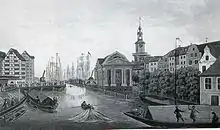
View of the city from circa 1810
- 1810 – August Wilhelm Heidemann becomes mayor.
- 1812 – School of church music founded.
- 1813 – Koenigsberg Observatory built.
- 1814 – Carl Friedrich Horn becomes mayor.
- 1826 – Johann Friedrich List becomes mayor.
- 1828 – Royal and University Library formed.[22]
- 1830 – Population: 54,000.[2]
- 1831 – Polish poet Wincenty Pol interned in the city following the unsuccessful Polish November Uprising. He wrote his first poems there.[24]
- 1833 – University's Department of Chemistry opens in Neurossgarten.
- 1838 – Rudolf von Auerswald becomes mayor.
- 1845
- Union Giesserei foundry in business.
- New Altstadt Church dedicated.
- Art academy opens.[25]
- 1851 – Grolman Bastion built.
- 1855
- Sailing Club founded.
- Rossgarten Gate rebuilt.
- 1856 – Königsberg Cathedral restored.[1]
- 1858 – Dohna Tower built.
- 1860 – Astronomic Bastion built.
- 1861
- 18 October: Coronation of William I, German Emperor, in the Schlosskirche.
- Albertina University new campus dedicated.
- 1863–1864 – Arms trafficking for Polish insurgents during the January Uprising in the Russian Partition of Poland, co-organized by Wojciech Kętrzyński.[26]
- 1867 – Population: 101,507.[27]
- 1875
- Johann Karl Adolf Selke becomes mayor.
- Königsberg Stock Exchange built in Vorstadt.[28]
- 1878 – Königsberger Allgemeine Zeitung (newspaper) in publication.[29]
- 1880
- Bronsart Fort built.
- Population: 140,800.[1]
- 1883 – High Bridge rebuilt.
- 1886 – Siemering Museum established.[30]
- 1889 – Eisenbahnbrücke (bridge) opens.
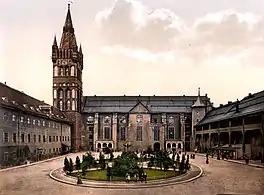
Königsberg Castle in the 1890s
- 1890 – Population: 161,666.[1]
- 1892 – Baltika Stadium opens.
- 1893 – Hermann Theodor Hoffmann becomes mayor.
- 1896 – Zoo founded.
- 1897 – Königsberger Tageblatt (newspaper) in publication.
- 1898 – Palaestra Albertina established.[31]
- 1900
- Football Club Königsberg formed.
- Population: 187,897.[23]
20th century
1900-1945
- 1901
- Queen Louise Memorial Church and Pillau-Königsberg canal built.[32][33]
- Königsberger Volkszeitung (newspaper) in publication.[34]
- 1903 – Siegfried Körte becomes mayor.
- 1905 - Population: 219,862.[1]
- 1906 – Bismarck tower built near city.
- 1907 – Church of the Holy Family built.
- 1912 – Stadthalle opens.
- 1913
- New Tragheim Church dedicated.
- Kunsthalle Königsberg (art gallery) opens.
- 1914 – City bombed by Russian forces.[35]
- 1919
- Hans Lohmeyer becomes mayor.
- City becomes part of the German Reich.
- Population: 260,895.[36]
- 1920 – 24 April: Consulate of Poland opened.[37]
- 1921 – Königsberg Devau Airport opens.
.JPG.webp)
Aerial view of the castle and city centre in 1925
- 1927 – City Hall relocated to Hansaplatz.
- 1928 – Königsberg City Museum opens.
- 1929 – Central railway terminal opens.
- 1931 – Last Polish book in the pre-1945 city published.[14]
- 1933 – Hellmuth Will becomes mayor.
- 1934 – Hansaplatz renamed Adolf-Hitler-Platz.
- 1939
- Lasch Bunker built in Paradeplatz.
- Population: 368,433.[35]
- 25 August: The local Gestapo issued an arrest warrant for all Polish teachers in the region.[38]
- August–September: Persecution of Poles, incl. mass arrests of Polish students and arrests of local Polish consul Jerzy Warchełowski and attaché Witold Winiarski.[39]
- October: The Germans established a forced labour camp for Romani people.[40]
- 1941 – 1 September: Aerial bombing by Soviet forces begins.
- 1942 – 24 June: The Nazi SS sends the first deportation of Jews from Königsberg and the province of East Prussia to extermination camps.[41]
- 1944
- August: Aerial bombing by British forces; city extensively damaged.
- 19 August: The Germans established a subcamp of the Stutthof concentration camp, in which around 500 Jews were subjected to forced labour.[42]
- 1945
- January: Subcamp of the Stutthof concentration camp dissolved.[42]
- January: Battle of Königsberg begins.
- February: Metgethen massacre.
- 9 April: Battle of Königsberg ends; Soviets in power.[35]
1946-1990s
- 1946
- April: City becomes part of the Russian Soviet Federative Socialist Republic, per Potsdam Agreement.[43]
- City renamed Kaliningrad after Bolshevik Mikhail Kalinin.
- City becomes seat of the newly formed Kaliningrad Oblast.
- Kaliningrad Regional Museum of History and Arts founded.
- Kaliningradskaya Pravda newspaper begins publication.[29]
- 1947 – Kaliningrad Regional Drama Theatre established.
- 1954 – Pishchevik Kaliningrad football club formed.
- 1956 – Population: 188,000.
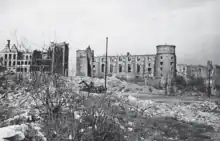
Castle ruins in the 1960s
- 1960 – Theatre on Mira Avenue rebuilt.
- 1965 - Population: 253,000.[44]
- 1967 – Kaliningrad State University active.
- 1979
- Khrabrovo Airport terminal built.
- Kaliningrad Amber Museum opens.
- 1985 - Population: 385,000.[45]
- 1988 – Kaliningrad State Art Gallery established.[46]
- 1989 – Population: 401,280; oblast 871,283.
- 1990
- 1994 – Kaliningrad State Technical University active.
- 1996 – Leonid Gorbenko becomes governor of Kaliningrad Oblast.[50]
- 1998 – The Voice from the Pregel Polish-language magazine in publication.
21st century
- 2001 – Vladimir Yegorov becomes governor of Kaliningrad Oblast.
- 2005
- July: 750th anniversary of city founding.[51]
- Kaiser Bridge reconstructed (approximate date).
- Georgy Boos becomes governor of Kaliningrad Oblast.
- 2007
- Alexander Jaroschuk becomes mayor.[52]
- Khrabrovo Airport new terminal opens.[53]
- 2008 – Cathedral of Christ the Saviour consecrated.
- 2010
- 30 January: Protest against governor Georgy Boos.[54]
- Population: 431,500;[55] oblast 941,873.
- Nikolay Tsukanov becomes governor of Kaliningrad Oblast.
- 2012 – Poland-Russia border near Kaliningrad Oblast opens.[56]
See also
- History of Kaliningrad
- Königsberg
- List of monarchs of Prussia, 1525-1701
- Timelines of other cities in the Northwestern Federal District of Russia: Pskov, St. Petersburg
References
- Chisholm, Hugh, ed. (1910). . Encyclopædia Britannica. Vol. 15 (11th ed.). Cambridge University Press. pp. 894–895.
- David Brewster, ed. (1830). "Königsberg". Edinburgh Encyclopædia. Edinburgh: William Blackwood.
- Richard Armstedt (1899). Geschichte der königl. Haupt- und Residenzstadt Königsberg in Preussen [History of the Royal Capital and Residence City of Königsberg in Prussia] (in German). Stuttgart: Hobbing & Büchle.
- "Sites and projects". sg39.ru. Retrieved 2018-01-30.
- Górski, Karol (1949). Związek Pruski i poddanie się Prus Polsce: zbiór tekstów źródłowych (in Polish). Poznań: Instytut Zachodni. p. 54.
- Górski, pp. 71–72
- Górski, p. 63
- Podbereski 2010, p. 113.
- "Kalendarz dat: 1465". Dzieje.pl (in Polish). Retrieved 16 July 2022.
- Górski, pp. 96–97, 214–215
- Małłek 1992, p. 248.
- Henri Bouchot (1890). "Topographical index of the principal towns where early printing presses were established". In H. Grevel (ed.). The book: its printers, illustrators, and binders, from Gutenberg to the present time. London: H. Grevel & Co.
- Małłek 1992, p. 249.
- Podbereski 2010, p. 114.
- Małłek 1992, p. 250.
- George Henry Townsend (1867), "Königsberg (Prussia)", A Manual of Dates (2nd ed.), London: Frederick Warne & Co.
- Małłek 1992, p. 252.
- Małłek 1992, p. 253.
- Małłek 1992, p. 254.
- Małłek 1992, pp. 254–255.
- Małłek 1992, p. 255.
- Julius Petzholdt (1853), Handbuch Deutscher Bibliotheken (in German), Halle: H.W. Schmidt, OCLC 8363581
- Benjamin Vincent (1910), "Konigsberg", Haydn's Dictionary of Dates (25th ed.), London: Ward, Lock & Co.
- Podbereski 2010, p. 115.
- Richard Armstedt (1895). Heimatkunde von Königsberg (in German). Königsberg: Koch.
- Podbereski 2010, p. 116.
- J. Niederstetter, ed. (1867). Staats-Almanach für das Königreich Preußen (in German). Berlin: Heymann.
- Norddeutscher Lloyd (1896), "Königsberg", Guide through Germany, Austria-Hungary, Italy, Switzerland, France, Belgium, Holland and England, Berlin: J. Reichmann & Cantor, OCLC 8395555
- "Kaliningrad Newspapers". WorldCat. USA: Online Computer Library Center. Retrieved 11 November 2013.
- Königliche Museen zu Berlin (1904). Kunsthandbuch für Deutschland (in German) (6th ed.). Georg Reimer.
- "Königsberg", Northern Germany (15th ed.), Leipzig: Karl Baedeker, 1910, OCLC 78390379
- Eugene van Cleef (1945). "East Baltic Ports and Boundaries: With Special Reference to Königsberg". Geographical Review. 35 (2): 257–272. doi:10.2307/211478. JSTOR 211478.
- United States Hydrographic Office (1917). Baltic Pilot. Vol. 1. Washington, D.C.: Government Printing Office.
- "Zeitungsinformationssystem ZEFYS" [Newspaper Information System] (in German). Berlin State Library. Retrieved 19 November 2016.
- Webster's Geographical Dictionary, Springfield, Massachusetts: G. & C. Merriam Co., 1960, p. 529, OL 5812502M
- "Germany: Principal Towns". Statesman's Year-Book. London: Macmillan and Co. 1921. hdl:2027/njp.32101072368440 – via Hathi Trust.
- Ceranka, Paweł; Szczepanik, Krzysztof (2020). Urzędy konsularne Rzeczypospolitej Polskiej 1918–1945. Informator archiwalny (in Polish). Warszawa: Naczelna Dyrekcja Archiwów Państwowych, Ministerstwo Spraw Zagranicznych. p. 196. ISBN 978-83-65681-93-5.
- Cygański, Mirosław (1984). "Hitlerowskie prześladowania przywódców i aktywu Związków Polaków w Niemczech w latach 1939-1945". Przegląd Zachodni (in Polish) (4): 41.
- Cygański, p. 42
- "Lager für Sinti und Roma Königsberg". Bundesarchiv.de (in German). Retrieved 7 May 2022.
- "Memorial Plaque to the Victims of the First Deportation from Königsberg". Information Portal to European Sites of Remembrance. Berlin, Germany: Stiftung Denkmal für die ermordeten Juden Europas. Retrieved 2019-07-18.
- Gliński, Mirosław. "Podobozy i większe komanda zewnętrzne obozu Stutthof (1939–1945)". Stutthof. Zeszyty Muzeum (in Polish). 3: 173. ISSN 0137-5377.
- Russell H. Fifield (1948). "International Affairs: The Postwar World Map: New States and Boundary Changes". American Political Science Review. 42 (3): 533–541. doi:10.2307/1949917. JSTOR 1949917. S2CID 147617453.
- "Population of capital cities and cities of 100,000 and more inhabitants". Demographic Yearbook 1965. New York: Statistical Office of the United Nations. 1966.
- United Nations Department of Economic and Social Affairs, Statistical Office (1987). "Population of capital cities and cities of 100,000 and more inhabitants". 1985 Demographic Yearbook. New York. pp. 247–289.
{{cite book}}: CS1 maint: location missing publisher (link) - "Russianmuseums.info". Russian Cultural Heritage Network. Retrieved 11 November 2013.
- Europa World Year Book 2004. Taylor & Francis. ISBN 1857432533.
- История Палаты [History of the Chamber] (in Russian). Калининградская торгово-промышленная палата (Kaliningrad Chamber of Commerce). Archived from the original on 12 April 2012. Retrieved 11 November 2013.
- G.J. Ashworth; J.E. Tunbridge (1999). "Old cities, new pasts: Heritage planning in selected cities of Central Europe". GeoJournal. 49 (1): 105–116. doi:10.1023/A:1007010205856. JSTOR 41147404. S2CID 133089435.
- Patrick E. Tyler (5 April 2000). "In a Russian Region Apart, Corruption Is King". New York Times. Retrieved 11 November 2013.
- "Kaliningrad marks key anniversary". BBC News. 3 July 2005. Retrieved 11 November 2013.
- "Mayors in Europe". City Mayors.com. London: City Mayors Foundation. Retrieved 11 November 2013.
- "Kaliningrad profile". BBC News. 31 May 2012. Retrieved 11 November 2013.
- "Restlessness in Russia's Western Outpost". New York Times. 25 March 2010. Retrieved 11 November 2013.
- "Population of Capital Cities and Cities of 100,000 or More Inhabitants". Demographic Yearbook 2011. United Nations Statistics Division. 2012.
- "Crack in the EU: Poland and Kaliningrad Open Borders for Locals". Spiegel Online. 2 August 2012. Retrieved 11 November 2013.
This article incorporates information from the German Wikipedia and Russian Wikipedia.
Bibliography
in English
- Published in the 18th-19th century
- Thomas Nugent (1749), "Königsberg", The Grand Tour, vol. 2: Germany and Holland, London: S. Birt, hdl:2027/mdp.39015030762572
- Richard Brookes (1786), "Konigsburg", The General Gazetteer (6th ed.), London: J.F.C. Rivington
- Jedidiah Morse; Richard C. Morse (1823), "Königsberg", A New Universal Gazetteer (4th ed.), New Haven: S. Converse
- Augustus Bozzi Granville (1829). "(Königsberg)". St. Petersburgh: A journal of travels to and from that capital. H. Colburn.
- "Königsberg", Leigh's New Descriptive Road Book of Germany, London: Leigh and Son, 1837
- "Königsberg". Penny Cyclopaedia. London. 1839.
- "Königsberg". Handbook for North Germany. London: J. Murray. 1877.
- John Ramsay McCulloch (1880), "Königsberg", in Hugh G. Reid (ed.), A Dictionary, Practical, Theoretical and Historical of Commerce and Commercial Navigation, London: Longmans, Green, and Co.
- W. Pembroke Fetridge (1884), "Königsberg", Harper's Hand-Book for Travellers in Europe and the East (23rd ed.), New York: Harper & Brothers, hdl:2027/nyp.33433066588363
- "Königsberg", Bradshaw's Illustrated Hand-book to Germany and Austria, London: W.J. Adams & Sons, 1896
- Published in the 20th century
- . Encyclopædia Britannica. Vol. 15 (11th ed.). 1910. pp. 894–895.
- "Kaliningrad", Scandinavian & Baltic Europe (4th ed.), Lonely Planet, 1999, p. 300+, OL 8314793M
- James Charles Roy (1999). The Vanished Kingdom: Travels Through the History of Prussia. Basic Books. ISBN 978-0-8133-3793-7.
- Olga Sezneva (2000). "Historical Representation and the Politics of Memory in Kaliningrad, Former Königsberg". Polish Sociological Review (131): 323–338. JSTOR 41274763.
- Published in the 21st century
in other languages
- Karl Faber (1840). Die Haupt- und Residenz-Stadt Königsberg in Preußen [Capital and Residence City of Königsberg in Prussia] (in German). Königsberg: Gräfe und Unzer.
- Alexander Jung (1846). Königsberg und die Königsberger (in German). Leipzig: Hermann Kirchner.
- F.W. Schubert (1855). Zur sechshundertjährigen Jubelfeier der Stadt Königsberg [600th Jubilee Celebration of the City of Königsberg] (in German). Königsberg: Verlag von Schubert und Seidel.
- "Konigsberg". Biblioteca geographica: Verzeichniss der seit der Mitte des vorigen Jahrhunderts bis zu Ende des Jahres 1856 in Deutschland (in German). Leipzig: Wilhelm Engelmann. 1858. (bibliography)
- August Wilhelm Grube (1875). "Königsberg". Charakterbilder Deutschen Landes und Lebens fur Schule und Haus (in German) (10th ed.). Leipzig: F. Brandstetter.
- "Königsberg". Brockhaus' Konversations-Lexikon (in German) (14th ed.). Leipzig: Brockhaus. 1898.
- P. Krauss; E. Uetrecht, eds. (1913). "Konigsberg". Meyers Deutscher Städteatlas [Meyer's Atlas of German Cities] (in German). Leipzig: Bibliographisches Institut.
- "Konigsberg", Deutscher Städteatlas (in German), vol. 2, Institut für vergleichende Städtegeschichte, 1979, ISBN 3891150008
- Małłek, Janusz (1992). "Polityka miasta Królewca wobec Polski w latach 1525–1701". Komunikaty Mazursko-Warmińskie (in Polish). No. 3–4.
- Podbereski, Wacław (2010). "Królewiec – Koenigsberg – Kaliningrad". Znad Wilii (in Polish). Vol. 4, no. 44. ISSN 1392-9712.
- Wolfgang Adam; Siegrid Westphal, eds. (2012). "Königsberg". Handbuch kultureller Zentren der Frühen Neuzeit: Städte und Residenzen im alten deutschen Sprachraum (in German). De Gruyter. pp. 1153+. ISBN 978-3-11-029555-9.
External links
Wikimedia Commons has media related to Königsberg.
Wikimedia Commons has media related to Kaliningrad.
- Europeana. Items related to Kaliningrad, various dates.
- Digital Public Library of America. Items related to Kaliningrad, various dates
- Links to fulltext city directories for Konigsberg via Wikisource
This article is issued from Wikipedia. The text is licensed under Creative Commons - Attribution - Sharealike. Additional terms may apply for the media files.
